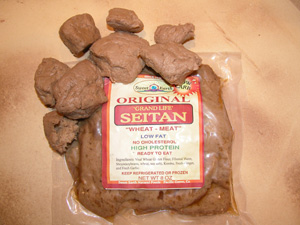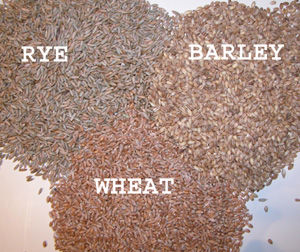Could It Be Celiac Disease?
Intestinal problems that linger despite adherence to the McDougall Diet may be the result of celiac disease (CD). As many as one in every hundred people—1% of the population—is affected by CD, a condition caused by gluten—protein molecules most commonly found in wheat, barley, and rye.1 Celiac disease prevents the small intestine from effectively absorbing necessary nutrients. This malabsorption then leads to diarrhea, abdominal pain, flatulence, weakness, and weight loss. These symptoms are often confused with irritable bowel syndrome and 10% of people who receive this diagnosis actually have CD.2 In late stages nutritional deficiencies can result.
So who gets CD? There is a genetic tendency to develop CD, but breastfeeding and the introduction of gluten-containing foods after the first three months of life reduce future risk of suffering from this kind of intolerance.3 Therefore, attention to early nutrition is the best form of prevention. Children should be breast-fed exclusively until 6 months of age. (No other foods, not even additional water or juice.) The intestinal tract does not fully mature until age 2 years and therefore, extra care should be taken with your child's diet during this vulnerable period—introduce non-gluten starches and fruits at about 6 months of age—continue partial breast feeding until 2 years of age, ideally. Food proteins from the mother's diet are present in her breast-milk; therefore, in cases where there is a family tendency for CD, mother's diet should be gluten-free during her nursing responsibility.4
|
 After sugar, gluten is the second most prevalent food substance in Western civilization. Traditionally, gluten is defined as a cohesive, elastic protein that is left behind after starch is washed away from wheat flour, and is actually made up of many different proteins. A wheat grain consists of 3 layers: the outer husk, the germ and the endosperm or "white flour." This "white flour" portion, which constitutes about 70% of the grain, contains the potentially toxic gluten for those people with CD. The rubbery strands you see when you knead dough to make bread is gluten. Pure wheat gluten, made by rinsing wheat flour with water until all that remains is the concentrated protein, is used as a meat substitute, and is called seitan (say-tan). On a vegetarian menu you will see this replacement referred to as mock-duck, -chicken, -fish or -beef. After sugar, gluten is the second most prevalent food substance in Western civilization. Traditionally, gluten is defined as a cohesive, elastic protein that is left behind after starch is washed away from wheat flour, and is actually made up of many different proteins. A wheat grain consists of 3 layers: the outer husk, the germ and the endosperm or "white flour." This "white flour" portion, which constitutes about 70% of the grain, contains the potentially toxic gluten for those people with CD. The rubbery strands you see when you knead dough to make bread is gluten. Pure wheat gluten, made by rinsing wheat flour with water until all that remains is the concentrated protein, is used as a meat substitute, and is called seitan (say-tan). On a vegetarian menu you will see this replacement referred to as mock-duck, -chicken, -fish or -beef.
|
Diagnosing Celiac Disease
The first step in confirming a clinical suspicion of celiac disease, based on the patient's story, is a blood test to measure levels of specific antibodies—Immunoglobulin A (IgA), anti-tissue transglutaminase (tTGA), or IgA anti-endomysium antibodies (AEA). If the patient has been eating gluten regularly and all three tests come back positive, there is a very high chance that the patient has celiac disease.5 However, the suspicion is only confirmed after a biopsy of the intestine shows classic changes characteristic of CD. (In medical terms the characteristic changes are villous atrophy, hyperplasia of the crypts and increased intraepithelial lymphocytes.) However, the connection between gluten and this disease is so close that the diagnosis can also be made when the patient experiences dramatic improvement of symptoms upon following a gluten-free diet.
Celiac Disease Leads to Many Other Problems
The intestinal tract must perform two diametrically opposed functions—it must allow nutrients (including food proteins) into the body and at the same time defend against invading proteins from bacteria, parasites, and viruses.6 This meeting of needs is accomplished by a single cell layer forming the "gut barrier." In people with CD, the gluten protein damages this barrier creating a "leaky gut." Now "foreign proteins" from microbes and food are indiscriminately allowed to pass through the intestinal wall—causing all kinds of troubles. People with untreated celiac disease have two to six times greater risk of dying, mainly due to an increase in the risk of lymphoma, and a much greater risk of suffering from autoimmune diseases, like type-1 diabetes and thyroiditis.1,2,5,7
|
Health Problems Common with CD
Autoimmune Diseases:
Type-1 diabetes
Hypothyroidism
Hyperthyroidism
Sjögren's syndrome
Scleroderma
Rheumatoid arthritis
Psoriasis
Lupus
Alopecia (hair loss)
Adrenal insufficiency
Vasculitis
Non-autoimmune Diseases:
Lymphomas
Other cancers
Dermatitis Herpetiformis (skin burning, prickling, itching or tingling)
Bone loss (osteopenia/osteoporosis)
Loss of dental enamel
Anemia (iron deficiency)
Liver dysfunction (elevated enzymes)
Growth retardation
Infertility
Delayed puberty
Neurologic disorders (cerebellar ataxia, migraine, neuropathy, epilepsy)
Autism8
Schizophrenia9
Fetal loss |
Diet: The Only Treatment for Celiac Disease
Celiac disease is a lifelong condition—therefore patients must stick to a diet low in gluten in order to regain lost health and remain disease-free. As with all dietary treatments, lack of compliance, usually due to insufficient motivation and information, is the greatest obstacle against success. Fortunately, strict adherence to a gluten-free diet allows the intestine to heal, stopping the malabsorption, and plugging the "leaky gut," which in turn reduces the risk of future autoimmune and non-autoimmune diseases.1,2,5-10
|
Offending Foods for CD10

Barley
Einkorn
Emmer
Kamut
Rye
Spelt
Triticale
Wheat*
durum and semolina
bulgur
seitan
Beer, ales, and malted drinks contain considerable gluten.
*Lactobacilli bacteria are used to make sourdough bread, which will remove (hydrolyze) most of the gluten and make the wheat tolerable for most people with CD.2
|
|
Foods Acceptable for CD10
Grains:
Amaranth
Buckwheat (or kasha)
Corn
Job's tears
Millet
Quinoa
Rice
Sorghum
Teff
Wild rice
Oats*11
Other Foods:
All root vegetables, like potatoes, yams, sweet potatoes, and cassava-root (tapioca)
All legumes**, more specifically, beans (including soy and chickpeas), peas and lentils
All green and yellow vegetables
All fruits
* Oats have been demonstrated in multiple studies to be free of toxic proteins and tolerated by most (but not all11) people with CD, but there is worry that commercial oat products may be contaminated with wheat.
**Legumes make extra gas, sometimes causing bloating and bowel discomfort. This reaction may be confused with symptoms of CD. |
The McDougall Program (with the above adjustments) works very well for people with gluten intolerance as well as almost all other health problems. Once diagnosed with celiac disease, people attempt to replace familiar foods, like breads and noodles, with gluten-free varieties. You might try "spaghetti" noodles made from rice, corn, quinoa, or buckwheat. Use corn tortillas instead of wheat flour wraps. Though it may take some time to find suitable gluten-free substitutions for favorite foods, the result is well worth the effort—simple, cost-free, side-effect-free relief from a serious lifelong condition.
You will also find considerable help on the internet by searching for celiac disease. Many gluten-free products are sold and most companies seem to have concern for other dietary issues, including vegetarian diets.
http://www.celiac.com
http://digestive.niddk.nih.gov/ddiseases/pubs/celiac/
A Wheat-Free Diet: Your Next Step to Excellent Health
Celiac disease is only one reason to consider eliminating wheat and similar grains (barley, rye) from your diet. Of all plant foods, wheat is the most common cause of food allergies and therefore will need to be eliminated when the basic McDougall Diet (which contains wheat) fails to solve problems, such as inflammatory arthritis, colitis, sinusitis, and asthma.
The most common and delicious way wheat is served is as flour made into breads, bagels, and pastas. However, additional nutritional problems are created by turning the whole wheat berry into a powdery material, the flour. This grinding process changes the physical properties so that the flour's calories are absorbed more rapidly and completely than calories in the original whole grain—making weight loss difficult for some people. Therefore, in the McDougall Program for Maximum Weight Loss all flour products are eliminated.
This simple modification of eliminating foods from the wheat family, and especially those processed into flours, may be the final essential step for some people to regain their lost health. So, if you are still having problems with weight loss and/or you're not feeling as well as you should, try centering your diet around potatoes, sweet potatoes, whole grain rice and beans with plenty of yellow and green vegetables and fresh fruits.
References:
1) Alaedini A, Green PH. Narrative review: celiac disease: understanding a complex autoimmune disorder. Ann Intern Med.2005 Feb 15;142(4):289-98.
2) Robins G, Howdle PD. Advances in celiac disease. Curr Opin Gastroenterol. 2005 Mar;21(2):152-61.
3) Norris JM, Barriga K, Hoffenberg EJ, Taki I, Miao D, Haas JE, Emery LM, Sokol RJ, Erlich HA, Eisenbarth GS, Rewers M. Risk of celiac disease autoimmunity and timing of gluten introduction in the diet of infants at increased risk of disease. JAMA.2005 May 18;293(19):2343-51.
4) Chirdo FG, Rumbo M, Anon MC, Fossati CA. Presence of high levels of non-degraded gliadin in breast milk from healthy mothers. Scand J Gastroenterol. 1998 Nov;33(11):1186-92.
5) Green PH, Jabri B. Coeliac disease. Lancet. 2003 Aug 2;362(9381):383-91.
6) Macdonald TT, Monteleone G. Immunity, inflammation, and allergy in the gut. Science. 2005 Mar 25;307(5717):1920-5.
7) Viljamaa M, Kaukinen K, Huhtala H, Kyronpalo S, Rasmussen M, Collin P. Coeliac disease, autoimmune diseases and gluten exposure. Scand J Gastroenterol. 2005 Apr;40(4):437-43.
8) Millward C, Ferriter M, Calver S, Connell-Jones G. Gluten- and casein-free diets for autistic spectrum disorder. Cochrane Database Syst Rev. 2004;(2):CD003498.
9) Eaton W, Mortensen PB, Agerbo E, Byrne M, Mors O, Ewald H. Coeliac disease and schizophrenia: population based case control study with linkage of Danish national registers. BMJ. 2004 Feb 21;328(7437):438-9.
10) Ciclitira PJ, Ellis HJ, Lundin KE. Gluten-free diet--what is toxic? Best Pract Res Clin Gastroenterol. 2005 Jun;19(3):359-71.
11) Arentz-Hansen H, Fleckenstein B, Molberg O, Scott H, Koning F, Jung G, Roepstorff P, Lundin KE, Sollid LM. The molecular basis for oat intolerance in patients with celiac disease. PLoS Med. 2004 Oct;1(1):e1. Epub 2004 Oct 19.
|